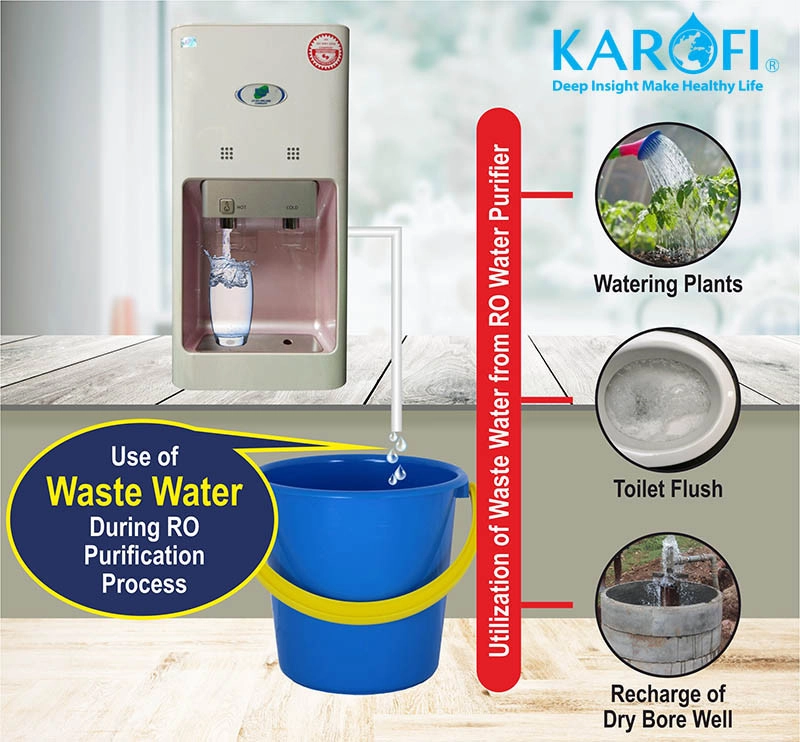Can the wastewater from a water filtration machine be used?
After passing through the RO water filtration system, in addition to the pure drinking water, there is also a portion of water that cannot pass through the RO membrane, called wastewater or residual water. So can the wastewater that comes out of the water discharge line of the water filtration machine be reused? Let's join Karofi Global to find the answer to this question!
1. Can wastewater from RO water purifiers be used?
The RO water filtration technology helps to purify a variety of different water sources. However, when an RO water purifier operates, for every 10 liters of water filtered, only 6 liters of pure water and 4 liters of wastewater are obtained.

According to experts, the wastewater from RO water purifiers can be reused because it is the wastewater of the RO membrane and not ordinary wastewater.
In addition, the RO membrane of a water purifier stands at the fourth position in the water filtration system. After passing through the first three filtration cores, the input water has been treated for all particles larger than 1 micrometer (0.001mm) and odor. When the water reaches the RO membrane, the pure water passes through the membrane and is collected in a tank, while the remaining part, containing bacteria and harmful minerals, is carried away through the wastewater outlet.
2. Using wastewater from RO water purifiers in a way that is safe for health
2.1 Do not use wastewater from the purifier for cooking or drinking
The water from the purifier is cleaner than the input tap water because it has passed through the first 3 filter cores of the machine. However, do not use this water for cooking or drinking as there may still be many types of bacteria smaller than 1 micron that exist in the water and heavy metals that have not been filtered out.
2.2 Carefully consider the input water source before deciding to use it
Reusing wastewater for each purpose also depends on the water source. If the input source is tap water, the wastewater source is relatively clean. But if the input source is well water, it depends on many factors such as the level of hardness, iron, manganese, etc.
Note that with well water, do not use it to wash clothes. The water source may have been contaminated with iron oxide, hardness, manganese, etc. causing the water to not be as clear as usual and may cause yellowing or discoloration of clothes.
2.3 Use a plastic container to store wastewater
You should use a plastic container to store the wastewater from the RO water purifier because the wastewater contains quite a lot of acids. Do not use a stainless steel container to avoid damaging the container when they react with each other.
If you have sensitive skin, wear gloves when using this water to avoid allergic reactions.
3. Ways to reuse wastewater from RO water purifiers
No longer need to worry about the problem of water purifiers producing a lot of wastewater, as this source of water can be utilized for the following purposes:
3.1 Use wastewater from the RO water purifier to wash cars

One car wash, especially for cars, can consume hundreds of liters of water. Therefore, make use of every source of water such as vegetable washing water, wastewater from water purifiers... to serve this demand.
Wastewater with a TDS level of 1200 - 1500 PPM is a safe water source for washing cars. In case the wastewater has a TDS index that is too high, you can dilute it with tap water to reduce the TDS level.
3.2 Use wastewater to water plants
The amount of water flowing from the wastewater valve of the water purifier should be reused to water plants. This method is extremely useful for urban residents as the TDS level in urban water tends to be lower.
To ensure the safety of trees in the garden, you need to start watering some types of trees. You should use wastewater to water plants for 15-20 days to monitor the effect of water on the development of plants.

Each type of tree will have different reactions when watered with wastewater from the water purifier. If you feel suitable, you should continue to use this water source to water plants for a long time.
Note that to be reusable in gardening and irrigation, the wastewater needs to have a TDS level equal to or less than 2100 PPM. In addition, you should also check the Sodium ratio in the water, this ratio must be below 60% to avoid affecting the soil fertility of water.
3.3 Clean the floor and do laundry
The wastewater from the RO water purifier flows continuously when the device is in operation, so you should use it for daily needs such as cleaning the floor, doing laundry...
Using wastewater from the RO water purifier to clean the floor will help you save dozens of liters of clean water every day. If the wastewater level is too high (above 2000 ppm), you should dilute it with tap water to avoid staining the floor.

In addition, you can also use the abundant wastewater from the RO water purifier to do laundry. However, water with high TDS is not suitable for some thin fabrics.
3.4 Make use of the wastewater produced by the water purifier to flush the toilet
Flushing the toilet requires us to consume a very large amount of water per day. Specifically, each flush can lose up to about 5 to 7 liters of clean water into the sewer. The solution to reduce the waste of clean water at this time is to use wastewater from the RO water purifier.
You also need to pay attention to the discoloration of the surface of the toilet bowl after a few days. If you clean the toilet bowl regularly with cleaning water, discoloration and salt buildup due to high TDS wastewater can be avoided.
Therefore, wastewater from water filtration systems can be reused for other purposes. However, to ensure safety, you also need to check the TDS, pH, inorganic and chemical impurities such as sodium... before use.
The above article has answered readers' questions about whether wastewater in water filtration systems can be used, whether it is clean, and notes when reusing this water source. Any questions about wastewater or detailed advice on Karofi water filtration systems, please contact us: Karofiglobal.com

















